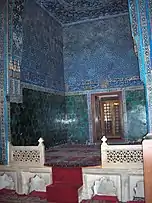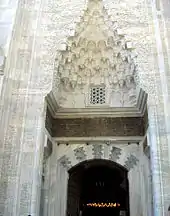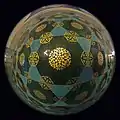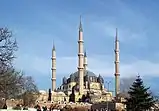Green Mosque, Bursa
The Green Mosque (Turkish: Yeşil Camii), also known as the Mosque of Mehmed I, is a part of a larger complex (Turkish: külliye) on the east side of Bursa, Turkey, the former capital of the Ottoman Turks before they captured Constantinople in 1453. The complex consists of a mosque, türbe, madrasah, kitchen and bath. The name Green Mosque comes from its green and blue interior tile decorations.[1]
| Green Mosque | |
|---|---|
Yeşil Camii | |
.jpg.webp) The north facade of the Green Mosque | |
| Religion | |
| Affiliation | Islam |
| Location | |
| Location | Bursa, Turkey |
 Location of the mosque in Turkey. | |
| Geographic coordinates | 40°10′55″N 29°04′28″E |
| Architecture | |
| Architect(s) | Hacı İvaz Pasha |
| Type | Mosque |
| Style | Islamic, Ottoman architecture |
| Groundbreaking | 1419 |
| Completed | 1421 |
| Minaret(s) | 2 |
History
The Green Mosque is often seen as the culmination of the early Ottoman architectural style, mainly due to the level of aesthetic and technical mastery displayed within the mosque.[2]
The Green Mosque was commissioned in 1412 by Sultan Mehmed I Çelebi, who ruled from 1413 to 1421, after a fight against his brothers to reunite the Ottoman Empire.[3] Mehmed I was buried in a mausoleum, called the Green Tomb, commissioned by his son and successor, Murad II, which resides in the complex.[3] The Green Mosque's exact completion date is uncertain, but it was built between 1419 and 1424.[4] Decorative work continued on the mosque after Mehmed I's death.[3]
The construction of the Green Mosque was supervised by architect and patron of the arts vizier Hacı İvaz Pasha, who had been a commander under Mehmed I.[4] A calligraphic inscription identifies Nakkas (the Artist) Ali bin Ilyas Ali as the supervisor of the interior tile decorations.[3] Ali bin Ilyas Ali is believed to have brought a diverse group of craftsmen called the “Masters of Tabriz” to assist him.[2] The "Masters of Tabriz" are referenced in a Persian inscription above the mosque's mihrab. Tabriz, a prominent artistic and cultural center in western Iran, was a particularly important channel through which Timurid influence arrived at the Green Mosque, as it was invaded by the Timurids throughout the fourteenth and fifteenth centuries.[5] Hacı İvaz Pasha was also reported to have “brought masters and men of skill from foreign lands” to help with the mosque's construction, according to 15th-century historian Aşıkpaşazade.[2] A Persian inscription inside the royal loge identifies Mehmet el-Mecnun as the artist who decorated the ceramics of the mosque.[3]
The Green Mosque is now a popular tourist destination in Bursa, which was recently named a UNESCO World Heritage Site.[6]
Architecture
Layout
The Green Mosque is based on an inverted T-plan and is a two-story, cube-shaped building with an extension on the south side. The mosque has a vestibule at the entrance leading up a short staircase to a central prayer hall.[7] This stairway has four marble cubby-holes (Turkish: papuçluk) on each side for slippers. These architectural inclusions point to the court being paved previously, although it is now carpeted.[8]
The central hall, which runs from north to south, is flanked by iwans (Turkish: eyvans) on the east and west. Both are domed and two stories high. There are two doors, smaller iwans, connecting to corner rooms on the first floor that are similar to those on the north side of the building, each containing a fireplace. The central hallway running north–south is intersected by a longer hallway running east–west.[7]
Within the central hallway, the main hall contains an octagonal, white marble fountain with a pool beneath the central dome—the highest dome in the mosque—which is illuminated by a lantern overhead. On either side of the pool, two further iwans lead to rooms for traveling dervishes, while a higher raised iwan directly behind the water (when seen from the central hall's entrance) leads to the prayer hall itself.[9] In this iwan, there is a mihrab niche on the south (qibla) side of the mosque, as well as two sets of four windows.
Immediately past the entrance of the Green Mosque lies a foyer. From here, wide corridors, framed by Byzantine columns, extend in both directions, ending in staircases leading to the royal chambers.[10] These corner rooms overlook the interior court, and connect to yet another small room leading to the royal box, which effectively functions as another iwan. These chambers contain the winding stairways leading up to the lofts.[11] Between these corner rooms, a passage opens to the balconies on the northern façade where the minaret steps begin. The two minarets opposite from each other on the north facade were later additions. A porch was designed but never built.
Exterior
Marble panels, a majority of which were replaced in the nineteenth century, overlay the mosque's edifice of hewn sandstone. The door is crowned by a half-dome with a cascade of muqarnas, whose face is covered with arabesques and Rumi inscriptions.[8] Above the niches on each side of the entrance door is an inscription dedicated to Hacı İvaz Pasha, the mosque's designer. Between the inscription and the muqarnas is a small window that illuminates the path to the sultan's box.[8]
The domes on top of the building were originally covered by blue and green tiles but are now clad in lead.[7] There are windows pierced into drums in the domes and on the exterior walls. An oculus above the ablution basin in the central hall was enclosed with a lantern at the time of restoration.[7]
The two minarets were fitted with stone spires, carved in the baroque manner, at the time of renovation. They can only be accessed through the sultan's apartments and by climbing up the winding stairs to the attics.[12]
Decorations
.jpg.webp)
Overview

The Green Mosque employs a distinctively diverse range of tile techniques (including black-line tiles (often mistaken for, yet technically separate from cuerda seca tiles), monochrome underglaze tiles, mosaic, and painted terra-cotta relief)[13] and colors (including green, blue, turquoise, white, yellow, light purple, and dark purple).[14] The black-line tiles, which compose the majority of the tiles within the mosque,[13] reflect an extensive Timurid influence that emerged through the empire's frequent invasions of Ottoman territories.[15] This influence can also be observed in Timurid ceramics[13] and architecture in Central Asia, such as the mausolea within the Shah-i Zinda shrine complex.[16] Moreover, an inscription above the mihrab designates the black-line tiles as “amal-i ustādhān-i Tabrīz” (work of the masters of Tabriz).[17] Meanwhile, the blue- and turquoise-glazed tiles in the entrance hallway and iwans, as well as the gold-adorned green hexagonal tiles in the iwans,[18] reveal a Seljuk influence (which can also be observed in the Karatay Madrasa in Konya).[19]
.jpg.webp)
Interior tile decoration
In the hallway connecting the vestibule to the prayer hall, dark green hexagonal tiles cover the walls, punctuated by a large roundel in the center of each wall. These roundels feature an intricate floral arabesque[20] in black-line tiles glazed in white, yellow, green, and blue.[21]
The recessed mahfils that flank the opening into the prayer hall are covered in similar dark green hexagonal wainscot tiles with gold decoration, with a large, intricate arabesque on each ceiling.[22]
More of these dark green hexagonal wainscot tiles, each decorated with a thick layer of gold overlay,[21] cover the large iwans flanking the prayer hall. A narrow floral black-line band surrounds these tiles, topped by a larger black-line band featuring a white and gold inscription upon a blue background.[21]
In the prayer hall itself, dark green hexagonal and triangular tiles (including some nineteenth and thirteenth century replacements)[23] cover the lower portions of the walls.[21]
The mihrab and its moulded tile frame feature a wide array of tile styles, shapes, and colors. Square black-line tiles, glazed in blue, purple, white, and yellow, cover the mihrab's interior with geometric motifs.[18] Equally colorful vegetal arabesques, composed of square and rectangular black-line tiles, decorate the spandrels.[24] The mihrab niche's twelve rows of muqarnas and two ribbed columns[25] feature similarly intricate and colorful tilework.
In the sultan's loge, the walls and ceiling are covered in gilded[20] black-line tiles that depict motifs of stars and polygons.[24] In contrast to these geometric motifs, the black-tile border around the opening into the mosque is decorated with vegetal motifs.[23]

.jpg.webp)
Carvings
Carved decorations exist along all exterior elements of the mosque, from the entryway to the mihrabs to the window frames.[26] The front portal of the mosque is made of carved marble and features a tall, recessed muqarnas niche, with unique marble tympana (decorated with arabesques)[27] framing the flanking windows.[28][23] This portal, framed with floral carvings and scripture,[23] references similar portals found in Seljuk mosques, madrasas, and mausolea.[19]
The two tabhane rooms connected to the central hallway, designed to provide lodging for travelers, contain carved plaster niches and ocaks (fireplaces with a tall hood).[22] A three-line calligraphic inscription is put in an arch over one of its doors.[22]
Restorations
Due to the 7.5 magnitude Bursa earthquake of 1855, the complex underwent extensive renovations planned by French architect and artist Léon Parvillée, beginning in 1863.[1] The exact completion date is unknown. Ahmet Vefik Paşa, the regional administrator of west Anatolia and a patron of the preservation of Ottoman cultural heritage, asked Parvillée to restore the major fourteenth and fifteenth century royal monuments of the city. During this period, Bursa was undergoing a transformation into a modern city.[29]
Parvillée first visited the Ottoman capital of Istanbul in 1851, later moving there in 1855. He worked in the empire as a decorator, contractor and architect.[30] Parvillée was well-versed in the main aspects of early Ottoman style due to his experiences living and working in the region as well as his extensive research of the subject.[30] The French consul of Bursa stated in 1906 that Parvillée remained in Bursa from 1862 to 1867, but this is disputed. It is unclear whether Parvillée merely planned the restoration and then left Bursa, or stayed to supervise the execution of his specifications. In any case, it is documented that Parvillée had returned to Paris by 1867 to design and build the Turkish pavilion displayed in the Exposition Universelle.[31]
Parvillée was involved in restoring the interior and the exterior of the mosque, including the tile work.[31] Parvillée restored the black-line tiles on the portal of the mosque.[5] The two minarets were rebuilt on an old base by Parvillée.[3] Polychrome painted decorations, which had previously adorned the upper parts of the walls and ceilings, were not restored.[1]
During a second restoration project that took place from 1941 to 1943, the ceramic facing of the tiles was removed and reinstalled.[5]
The Green Mosque underwent another renovation, starting in 2010 and reopening on May 11, 2012, which cost 1.8 million Turkish Liras.[32]
Gallery
 The facade and west side of the mosque.
The facade and west side of the mosque. The entrance to the mosque, featuring a carved muqarnas portal.
The entrance to the mosque, featuring a carved muqarnas portal. An intricately carved marble tympanum above an exterior window of the mosque.
An intricately carved marble tympanum above an exterior window of the mosque. An intricately carved marble tympanum above an exterior window of the mosque.
An intricately carved marble tympanum above an exterior window of the mosque. The marble fountain within an octagonal pool in the prayer hall.
The marble fountain within an octagonal pool in the prayer hall..jpg.webp) The prayer hall of the mosque.
The prayer hall of the mosque. The mihrab of the mosque. Above the mihrab is an inscription in Persian, reading “amal-i ustādhān-i Tabrīz” (work of the masters of Tabriz).
The mihrab of the mosque. Above the mihrab is an inscription in Persian, reading “amal-i ustādhān-i Tabrīz” (work of the masters of Tabriz)..jpg.webp) The opening to the second-floor sultan's loge, as seen from the prayer hall.
The opening to the second-floor sultan's loge, as seen from the prayer hall. Calligraphic inscription over the door of a tabhane room.
Calligraphic inscription over the door of a tabhane room. Fish-eye view of the domes.
Fish-eye view of the domes. Gilded decoration of the tiles in one of the side iwans.
Gilded decoration of the tiles in one of the side iwans. Black-line tile decoration within the mosque.
Black-line tile decoration within the mosque. Black-line tiles decorating the mihrab.
Black-line tiles decorating the mihrab._-_15th_century_-_MET_-_Inventory_number_1998.246.jpg.webp) A tile from the Yeşil Türbe (Green Tomb), which was situated in the same complex as the Green Mosque. Similarly colorful and intricate tiles were used throughout the Green Mosque, particularly in the mihrab.
A tile from the Yeşil Türbe (Green Tomb), which was situated in the same complex as the Green Mosque. Similarly colorful and intricate tiles were used throughout the Green Mosque, particularly in the mihrab.
See also
References
- "Yeşil Cami | Archnet". www.archnet.org. Retrieved 2019-03-10.
- Ersoy, Ahmet (2007-01-01). "Architecture and the Search for Ottoman Origins in the Tanzimat Period". Muqarnas Online. 24 (1): 117–139. doi:10.1163/22118993-90000113. ISSN 0732-2992.
- Freely, John (2011). A history of Ottoman architecture. WIT Press. ISBN 9781845645069. OCLC 714042767.
- "Ivaz bin Ahi Bayezid". Archnet. Retrieved 2019-03-10.
- Blessing, Patricia (September 2017). "Seljuk Past and Timurid Present: Tile Decoration of the Yeşil Külliye in Bursa". Gesta. 56 (2): 225–250. doi:10.1086/692804. ISSN 0016-920X.
- Centre, UNESCO World Heritage. "Bursa and Cumalıkızık: the Birth of the Ottoman Empire". UNESCO World Heritage Centre. Retrieved 2019-04-27.
- "Yeşil Cami". Archnet.
- Godfrey, Goodwin (1971). A History of Ottoman Architecture. Baltimore: Johns Hopkins Press. pp. 64. ISBN 978-0801812026.
- Freely, John (2011). A History of Ottoman Architecture. WIT Press. p. 47. ISBN 9781845645069.
- Godfrey, Goodwin (1971). A History of Ottoman Architecture. Baltimore: Johns Hopkins Press. pp. 59. ISBN 978-0801812026.
- Godfrey, Goodwin (1971). A History of Ottoman Architecture. Baltimore: Johns Hopkins Press. pp. 60. ISBN 978-0801812026.
- Godfrey, Goodwin (1971). A History of Ottoman Architecture. Baltimore: Johns Hopkins Press. pp. 65. ISBN 978-0801812026.
- Blessing, Patricia (2017). "Seljuk Past and Timurid Present: Tile Decoration of the Yeşil Külliye in Bursa". Gesta. 56 (2): 236. doi:10.1086/692804.
- Blessing, Patricia (2017). "Seljuk Past and Timurid Present: Tile Decoration of the Yeşil Külliye in Bursa". Gesta. 56 (2): 238. doi:10.1086/692804.
- Blessing, Patricia (2017). "Seljuk Past and Timurid Present: Tile Decoration of the Yeşil Külliye in Bursa". Gesta. 56 (2): 227. doi:10.1086/692804.
- Blessing, Patricia (2017). "Seljuk Past and Timurid Present: Tile Decoration of the Yeşil Külliye in Bursa". Gesta. 56 (2): 242. doi:10.1086/692804.
- Blessing, Patricia (2017). "Seljuk Past and Timurid Present: Tile Decoration of the Yeşil Külliye in Bursa". Gesta. 56 (2): 238–9. doi:10.1086/692804.
- Blessing, Patricia (2017). "Seljuk Past and Timurid Present: Tile Decoration of the Yeşil Külliye in Bursa". Gesta. 56 (2): 237. doi:10.1086/692804.
- Blessing, Patricia (2017). "Seljuk Past and Timurid Present: Tile Decoration of the Yeşil Külliye in Bursa". Gesta. 56 (2): 248. doi:10.1086/692804.
- Goodwin, Godfrey (1971). A History of Ottoman Architecture. Johns Hopkins Press. p. 60.
- Bernus-Taylor, Marthe (1997). "Le décor du 'Complexe Vert' à Bursa, reflet de l'art timouride". Cahiers d'Asie Centrale. 3/4: 253.
- Goodwin, Godfrey (1971). A History of Ottoman Architecture. Johns Hopkins Press. p. 61.
- "Yeşil Cami". Archnet.
- Bernus-Taylor, Marthe (1997). "Le décor du 'Complexe Vert' à Bursa, reflet de l'art timouride". Cahiers d'Asie Centrale. 3/4: 254.
- Goodwin, Godfrey (1971). A History of Ottoman Architecture. Johns Hopkins Press. p. 62.
- Freely, John (2011). A History of Ottoman Architecture. WIT Press. p. 45. ISBN 9781845645069.
- Goodwin, Godfrey (1971). A History of Ottoman Architecture. Johns Hopkins Press. p. 64.
- Bernus-Taylor, Marthe (1997). "Le décor du 'Complexe Vert' à Bursa, reflet de l'art timouride". Cahiers d'Asie Centrale. 3/4: 252.
- Ersoy, Ahmet (2017-07-05). Architecture and the late Ottoman historical imaginary : reconfiguring the architectural past in a modernizing empire. ISBN 9781351576000. OCLC 999614479.
- Girardelli, Miyuki Aoki (2006). Léon Parvillée and the Discourse on "Turkish" Architecture. pp. 160, 164, 165.
- Saint-Laurent, Béatrice (1986). Léon Parvillée, His Role as Restorer of Bursa's Monuments and His Contribution to the Exposition Universelle of 1867.
- "Historic mosque opens after renovation in Bursa province". Hürriyet Daily News. Retrieved 2019-03-10.
External links
| Wikimedia Commons has media related to Green Mosque. |



.svg.png.webp)